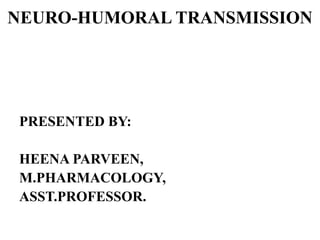
NEUROHUMORAL TRANSMISSION
- 1. NEURO-HUMORAL TRANSMISSION PRESENTED BY: HEENA PARVEEN, M.PHARMACOLOGY, ASST.PROFESSOR.
- 2. NEURO-HUMORAL TRANSMISSION Neurohumoral transmission implies that nerves transmit their message across synapses and neuro-effector junctions by the release of humoral chemical) messengers. Junctional transmission was thought to be electrical (it does occur in some lower animals and probably in certain areas of mammalian brain) but observations at the turn of last century prompted Elliott (1905) to suggest that sympathetic nerves functioned by the release of an adrenaline-like substance, and Dixon (1907) to propose that vagus released a muscarine like chemical. Otto Loewi (1921) provided direct proof of humoral transmission by perfusing two frog hearts in series. Stimulation of vagus nerve of the first heart caused arrest of both.
- 3. To be considered as a postjunctionally acting neurohumoral transmitter a substance must fulfill the following criteria: It should be present in the presympathetic neuron (usually along with enzymes synthesizing it). It should be released in the medium following nerve stimulation. Its application should produce responses identical to those produced by nerve stimulation. Its effects should be antagonized or potentiated by other substances which similarlv alter effects of nerve stimulation.
- 4. Steps in neurohumoral transmission:
- 5. 1. lmpulse conduction : The resting transmembrane potential (-70 mV) is established by high K* permeability of axonal membrane and high axoplasmic concentration of this ion coupled with low Na* permeabilitv and its active extrusion from the neuron stimulation or arrival of an electrical impulse causes a sudden increase in Na* conductance depolarization and overshoot (reverse polarization, inside becoming 20 mV positive); K* ions then move out in the direction of their concentration gradient & repolarisation occurs. Ionic distribution is normalized during the refractory period by the activation of Na* K* pump. The action potential (AP) thus generated sets up local circuit currents which activate ionic channels at the next excitable part of the membrane (next node of Ranvier in myelinated nerve) and the AP is propagated without decrement.
- 6. 2.Transmitter release: The transmitter (excitory or inhibitory) is stored in prejunctional nerve endings within sympathetic vesicles. Nerve impulse promotes fusion of vesicular and neuronal membranes through Ca+2 entry which fluidizes membranes. All contents of the vesicle transmitter, enzymes and other proteins) are extruded (exocytosis) in the junctional cleft. The release process can be modulated by the transmitter itself and by other agents through activation of specific receptors located on the prejunctional membrane. Example : Noradrenaline (NA) release is inhibited by NA (receptor), dopamine, adenosine, prostaglandins and enkephalins while isoprenaline (B2 receptor) and angiotensin AT1 receptor) increase NA release.
- 7. 3.Transmitter action on postiunctional membrane: The released transmitter combines with specific receptors on the postjunctional membrane and depending on its nature induces an excitatory postsynaptic potential (EPSP) or an inhibitory postsynaptic potential (IPSP). EPSP : Increase in permeability to all cations -> Na* or Ca2* influx (through fast or slow channels) causes depolarization followed by K* efflux. These ionic movements are passive as the flow is down the concentration gradients. IPSP : Increase in permeability to smaller ions, i.e. K* and Cl- (hydrated K+ ion is smaller than hydrated Na* ion) only, so that K* moves out and Cl- moves in (in the direction of their concentration gradients) resulting in hyperpolarisation.
- 8. 4. Postjunctional activity: A suprathreshold EPSP generates a propagated postjunctional AP which results in nerve impulse (in neurone), contraction (in muscle) or secretion (in gland). An IPSP stabilizes the postjunctional membrane and resists depolarizing stimuli. 5. Termination of transmitter action : Following its combination with the receptor, the transmitter is either locally degraded (e.g. ACh) or is taken back into the prejunctional neurone by active uptake or diffuses away (e.g. NA,GABA).
- 9. Specific carrier proteins like norepinephrine transporter (NET), dopamine transporter (DAT), serotonin transporter (SERT) are expressed on the axonal membrane for this purpose. The rate of termination of transmitter action governs the rate at which responses can be transmitted across a junction (1 to 1000/sec).
- 10. Co-Transmission It has now become apparent that the classical one neuron one transmitter' model is an over simplification. Most peripheral and central neurons have been shown to release more than one active substance when stimulated. In the ANS, besides the primary transmitters ACh and NA, neurons have been found to elaborate purines (ATP, adenosine), peptides (vasoactive intestinal peptide or VIP, neuropeptide-Y or NPY, substance P, enkephalins, somatostatin, etc.), nitric oxide and prostaglandins as co-transmitters. In most autonomic cholinergic neurons VIP is associated with ACh, while ATP is associated with both Ach and NA.
- 11. Vascular adrenergic nerves contain NPY which causes long lasting vasoconstriction. The co-transmitter is stored in the same neuron but in distinct synaptic vesicles or locations. However, ATP is stored with NA in the same vesicle. On being released by the nerve impulse it may serve to regulate the presynaptic release of the primary transmitter and,/or postsynaptic sensitivity to it (neuromodulator role). The co-transmitter may also serve as an alternative transmitter in its own right and/or exert a trophic influence on the sympathetic structures
- 12. Nonadrenergic, noncholinergic (NANC) transmission has been demonstrated in the autonomic innervation of the gut, vas deferens, urinary tract, salivary glands and certain blood vessels, where nerve stimulation is able to evoke limited responses even in the presence of total adrenergic and cholinergic blockade. For example, it has been shown that stimulation of sympathetic nerve to guinea pig vas deferens elicits a biphasic contractile response, the initial short-lasting phase of which is mediated by ATP (through P2 receptors) and the second longer lasting phase by NA (through u1 receptors). Many anomalous findings have been explained by the revelation of cotransmission.
- 14. TH9K UH!